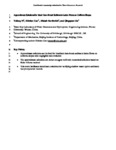Approximate Solutions for Ideal Dam‐Break Sediment‐Laden Flows on Uniform Slopes
| dc.contributor.author | Ni, Yufang | |
| dc.contributor.author | Cao, Zhixian | |
| dc.contributor.author | Borthwick, Alistair | |
| dc.contributor.author | Liu, Qingquan | |
| dc.date.accessioned | 2021-08-22T16:29:13Z | |
| dc.date.available | 2021-08-22T16:29:13Z | |
| dc.date.issued | 2018-04 | |
| dc.identifier.issn | 0043-1397 | |
| dc.identifier.issn | 1944-7973 | |
| dc.identifier.uri | http://hdl.handle.net/10026.1/17698 | |
| dc.description.abstract |
<jats:title>Abstract</jats:title><jats:p>Shallow water hydro‐sediment‐morphodynamic (SHSM) models have been applied increasingly widely in hydraulic engineering and geomorphological studies over the past few decades. Analytical and approximate solutions are usually sought to verify such models and therefore confirm their credibility. Dam‐break flows are often evoked because such flows normally feature shock waves and contact discontinuities that warrant refined numerical schemes to solve. While analytical and approximate solutions to clear‐water dam‐break flows have been available for some time, such solutions are rare for sediment transport in dam‐break flows. Here we aim to derive approximate solutions for ideal dam‐break sediment‐laden flows resulting from the sudden release of a finite volume of frictionless, incompressible water‐sediment mixture on a uniform slope. The approximate solutions are presented for three typical sediment transport scenarios, i.e., pure advection, pure sedimentation, and concurrent entrainment and deposition. Although the cases considered in this paper are not real, the approximate solutions derived facilitate suitable benchmark tests for evaluating SHSM models, especially presently when shock waves can be numerically resolved accurately with a suite of finite volume methods, while the accuracy of the numerical solutions of contact discontinuities in sediment transport remains generally poorer.</jats:p> | |
| dc.format.extent | 2731-2748 | |
| dc.language | en | |
| dc.language.iso | en | |
| dc.publisher | American Geophysical Union (AGU) | |
| dc.title | Approximate Solutions for Ideal Dam‐Break Sediment‐Laden Flows on Uniform Slopes | |
| dc.type | journal-article | |
| dc.type | Journal Article | |
| plymouth.issue | 4 | |
| plymouth.volume | 54 | |
| plymouth.publication-status | Published | |
| plymouth.journal | Water Resources Research | |
| dc.identifier.doi | 10.1002/2017wr021340 | |
| plymouth.organisational-group | /Plymouth | |
| plymouth.organisational-group | /Plymouth/Faculty of Science and Engineering | |
| plymouth.organisational-group | /Plymouth/Faculty of Science and Engineering/School of Engineering, Computing and Mathematics | |
| plymouth.organisational-group | /Plymouth/Users by role | |
| plymouth.organisational-group | /Plymouth/Users by role/Academics | |
| dc.identifier.eissn | 1944-7973 | |
| dc.rights.embargoperiod | Not known | |
| rioxxterms.versionofrecord | 10.1002/2017wr021340 | |
| rioxxterms.licenseref.uri | http://www.rioxx.net/licenses/all-rights-reserved | |
| rioxxterms.type | Journal Article/Review |


